A Ground Moving Target Detection Method for Seismic and Sound Sensor Based on Evolutionary Neural Networks
Abstract
:1. Introduction
2. Signal Preprocessing
3. Proposed Method
3.1. FSND-ENN Principle
3.1.1. Initialization Process
3.1.2. Evaluation Process
3.1.3. Evolutionary Process
3.2. Step of Feature Selection and Network Design
- (1)
- Calculate the 120 features of the training and testing data and form them into feature vectors;
- (2)
- Design the parameters of the evolutionary neural network, where the parameters include population size, crossover probability, variation probability, and the number of evolutionary generations, and randomly generate a primitive population;
- (3)
- For the genetic information in the population, generate the feature vector corresponding to each individual with the neural network, and calculate the fitness of each individual. In the process of fitness calculation, the neural network is trained with 1500 epochs using the training set mentioned above, and the classification score of the trained network for the test set is the score of the classification performance in the fitness calculation of this network;
- (4)
- Generate offspring populations through election, crossover, and mutation of parent populations;
- (5)
- Determine whether the requirement of evolutionary generations is satisfied. If so, the individual with the highest adaptation degree is output; if not, repeat step 3.
4. Experimental Results
4.1. Experimental Hardware
4.2. TRESS01 Datasets
4.3. Evaluation Metrics
4.4. Experimental Results on TRESS01 Dataset
4.5. Comparison with Benchmark Methods
5. Conclusions
Author Contributions
Funding
Institutional Review Board Statement
Informed Consent Statement
Data Availability Statement
Conflicts of Interest
References
- Bojor, L.; Cîrdei, I.A. Unattended Ground Sensor Borders—The Forgotten Solution for Afghanistan. In Proceedings of the International Conference Knowledge-Based Organization, Sibiu, Romania, 11 June 2021; Volume 27, pp. 8–13. [Google Scholar]
- Li, F.; Clemente, J.; Valero, M.; Tse, Z.; Song, W.Z. Smart Home Monitoring System via Footstep Induced Vibrations. IEEE Syst. J. 2019, 14, 3383–3389. [Google Scholar] [CrossRef]
- Clemente, J.; Li, F.; Valero, M.; Song, W.Z. Smart Seismic Sensing for Indoor Fall Detection, Location, and Notification. IEEE J. Biomed. Health 2019, 24, 524–532. [Google Scholar] [CrossRef]
- Mukhopadhyay, B.; Anchal, S.; Kar, S. Detection of an Intruder and Prediction of His State of Motion by Using Seismic Sensor. IEEE Sens. J. 2017, 18, 703–712. [Google Scholar] [CrossRef]
- Trnkoczy, A. Understanding and parameter setting of STA/LTA trigger algorithm. In IASPEI New Manual of Seismological Observatory Practice (NMSOP); Deutsches GeoForschungsZentrum GFZ: Potsdam, Germany, 2002; Volume 2, pp. 1–19. [Google Scholar]
- Anchal, S.; Mukhopadhyay, B.; Kar, S. Predicting gender from footfalls using a seismic sensor. In Proceedings of the 2017 9th International Conference on Communication Systems and Networks (COMSNETS), Bengaluru, India, 4–8 January 2017; pp. 47–54. [Google Scholar]
- Damarla, T.; Mehmood, A.; Sabatier, J. Detection of people and animals using non-imaging sensors. In Proceedings of the 14th International Conference on Information Fusion, Chicago, IL, USA, 5–8 July 2011; pp. 1–8. [Google Scholar]
- Sabatier, J.M.; Ekimov, A.E. A Review of Human Signatures in Urban Environments Using Seismic and Acoustic Methods. In Proceedings of the IEEE Conference on Technologies for Homeland Security, Waltham, MA, USA, 12–13 May 2008. [Google Scholar]
- Evans, N. Automated Vehicle Detection and Classification Using Acoustic and Seismic Signals. Ph.D. Thesis, University of York, York, UK, 2010. [Google Scholar]
- Choudhary, P.; Goel, N.; Saini, M. A Seismic Sensor based Human Activity Recognition Framework using Deep. In Proceedings of the 2021 17th IEEE International Conference on Advanced Video and Signal Based Surveillance (AVSS), 16–19 November 2021; IEEE: Washington, DC, USA, 2021; pp. 1–8. [Google Scholar]
- Wellman, M.C.; Srour, N.; Hillis, D.B. Feature extraction and fusion of acoustic and seismic sensors for target identification. In Proceedings of the Peace and Wartime Applications and Technical Issues for Unattended Ground Sensors, Orlando, FL, USA, 22–23 April 1997; SPIE: Orlando, FL, USA, 1997; pp. 139–145. [Google Scholar]
- Cheng, Z.; Gao, M.; Liang, X.; Liu, L. Incipient fault detection for the planetary gearbox in rotorcraft based on a statistical metric of the analog tachometer signal. Measurement 2019, 151, 107069. [Google Scholar] [CrossRef]
- Küçükbay, S.E.; Sert, M.; Yazici, A. Use of Acoustic and Vibration Sensor Data to Detect Objects in Surveillance Wireless Sensor Networks. In Proceedings of the International Conference on Control Systems & Computer Science, Bucharest, Romania, 29–31 May 2017. [Google Scholar]
- Bin, K.; Long, Y.; Tong, X.; Lin, J. Ground Moving Target Detection with Seismic Fractal Features. IEEE Geosci. Remote Sens. Lett. 2021, 19, 1–5. [Google Scholar] [CrossRef]
- Zhong, Z.; Li, H. Recognition and prediction of ground vibration signal based on machine learning algorithm. Neural Comput. Appl. 2020, 32, 1937–1947. [Google Scholar] [CrossRef]
- Jin, X.; Gupta, S.; Ray, A.; Damarla, T. Multimodal sensor fusion for personnel detection. In Proceedings of the International Conference on Information Fusion, Chicago, IL, USA, 5–8 July 2011. [Google Scholar]
- Huang, J.; Zhou, Q.; Zhang, X.; Song, E.; Li, B.; Yuan, X. Seismic Target Classification Using a Wavelet Packet Manifold in Unattended Ground Sensors Systems. Sensors 2013, 13, 8534–8550. [Google Scholar] [CrossRef] [PubMed]
- Narayanaswami, R.; Gandhe, A.; Tyurina, A.; Mehra, R.K. Sensor fusion and feature-based human/animal classification for Unattended Ground Sensors. In Proceedings of the 2010 IEEE International Conference on Technologies for Homeland Security (HST), Waltham, MA, USA, 8–10 November 2010. [Google Scholar]
- Dibazar, A.A.; Yousefi, A.; Park, H.O.; Bing, L.; George, S.; Berger, T.W. Intelligent acoustic and vibration recognition/alert systems for security breaching detection, close proximity danger identification, and perimeter protection. In Proceedings of the 2010 IEEE International Conference on Technologies for Homeland Security (HST), Waltham, MA, USA, 8–10 November 2010. [Google Scholar]
- Bin, K.; Luo, S.; Zhang, X.; Lin, J.; Tong, X. Compressive Data Gathering with Generative Adversarial Networks for Wireless Geophone Networks. IEEE Geosci. Remote Sens. Lett. 2020, 18, 558–562. [Google Scholar] [CrossRef]
- Wang, Y.; Cheng, X.; Zhou, P.; Li, B.; Yuan, X. Convolutional neural network-based moving ground target classification using raw seismic waveforms as input. IEEE Sens. J. 2019, 19, 5751–5759. [Google Scholar] [CrossRef]
- Bin, K.; Lin, J.; Tong, X. Edge Intelligence-Based Moving Target Classification Using Compressed Seismic Measurements and Convolutional Neural Networks. IEEE Geosci. Remote Sens. Lett. 2021, 19, 1–5. [Google Scholar] [CrossRef]
- Jin, G.; Ye, B.; Wu, Y.; Qu, F. Vehicle Classification Based on Seismic Signatures Using Convolutional Neural Network. IEEE Geosci. Remote Sens. Lett. 2018, 16, 628–632. [Google Scholar] [CrossRef]
- Xu, T.; Wang, N.; Xu, X. Seismic Target Recognition Based on Parallel Recurrent Neural Network for Unattended Ground Sensor Systems. IEEE Access 2019, 7, 137823–137834. [Google Scholar] [CrossRef]
- Li, X.; Wang, N.; Ding, Y.; Xing, K. Research on Moving Ground Target Classification Method for Seismic and Acoustic Sensors. In Proceedings of the International Conference on Autonomous Unmanned Systems, Changsha, China, 24–26 September 2021; Springer: Berlin/Heidelberg, Germany, 2021; pp. 852–859. [Google Scholar]
- Sabatier, J.M.; Ekimov, A.E. Range limitation for seismic footstep detection. In Proceedings of the SPIE Defense and Security Symposium, Orlando, FL, USA, 16–20 March 2008; SPIE: Bellingham, WA, USA, 2008; Volume 6963, pp. 247–258. [Google Scholar]
- Liu, S.; Jiang, W.; Wu, L.; Wen, H.; Wang, Y. Real-Time Classification of Rubber Wood Boards Using an SSR-Based CNN. IEEE Trans. Instrum. Meas. 2020, 69, 8725–8734. [Google Scholar] [CrossRef]
- Peng, Z.-Q.; Cao, C.; Huang, J.-Y.; Liu, Q.-S. Seismic signal recognition using improved BP neural network and combined feature extraction method. J. Cent. South Univ. 2014, 21, 1898–1906. [Google Scholar]
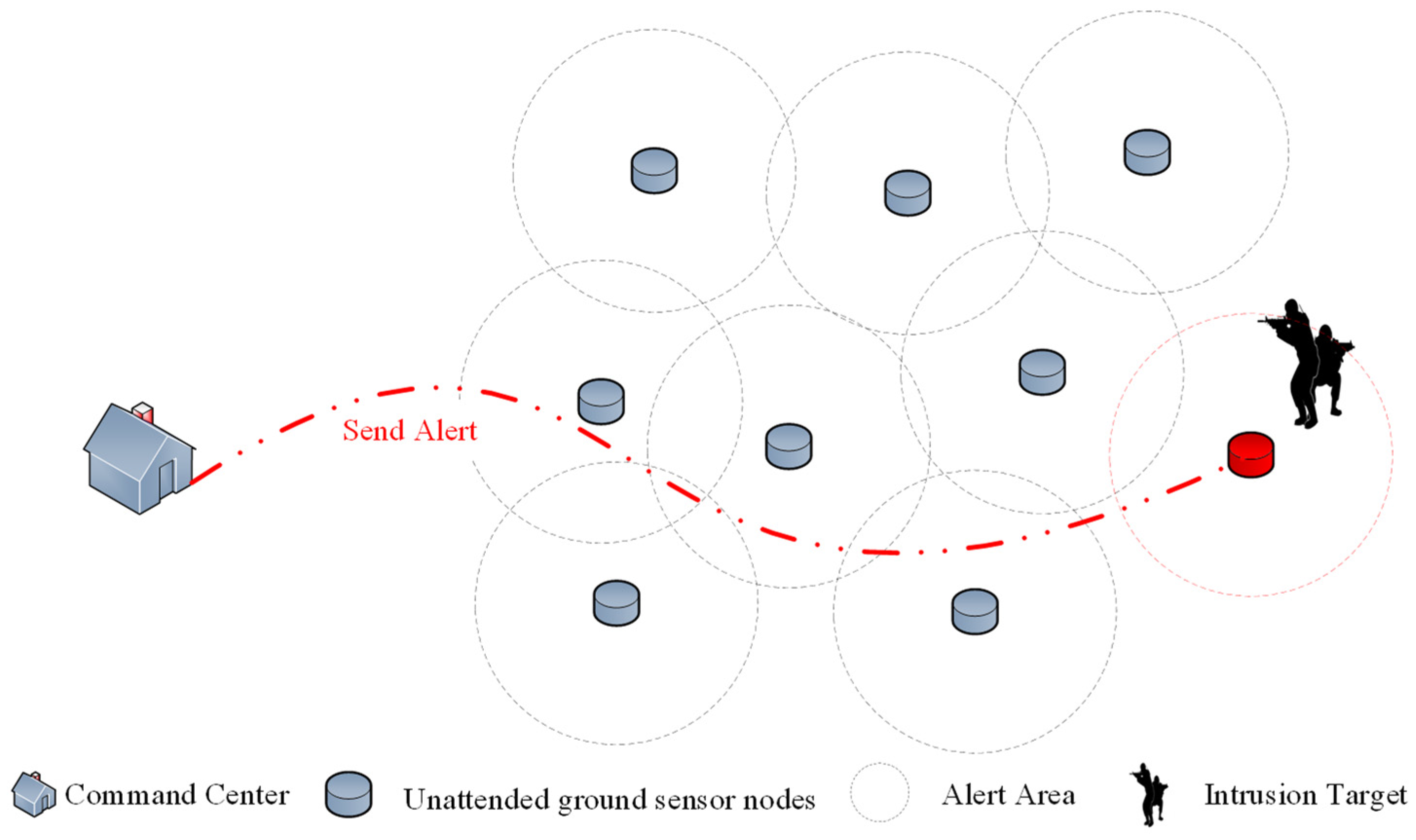
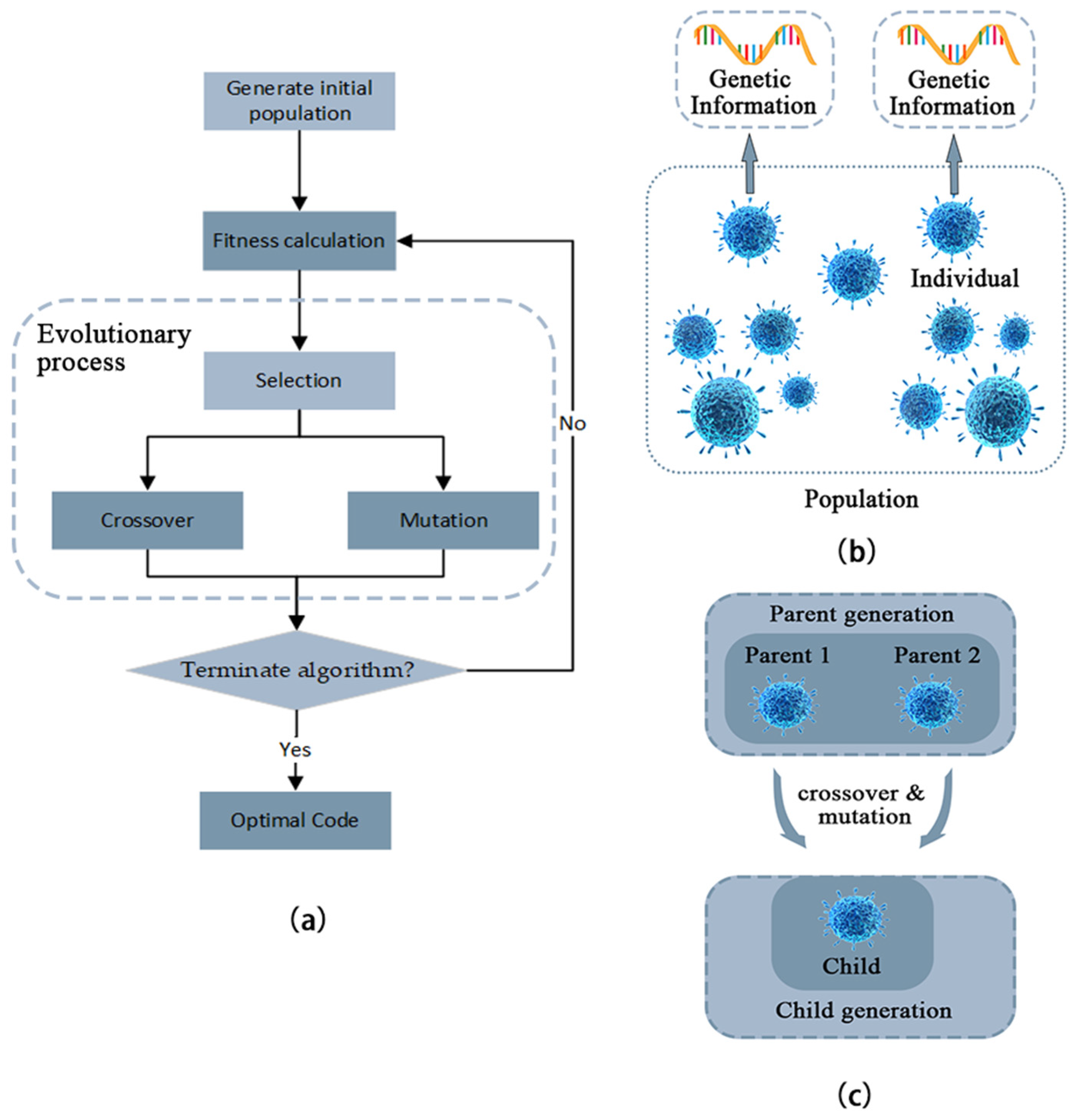
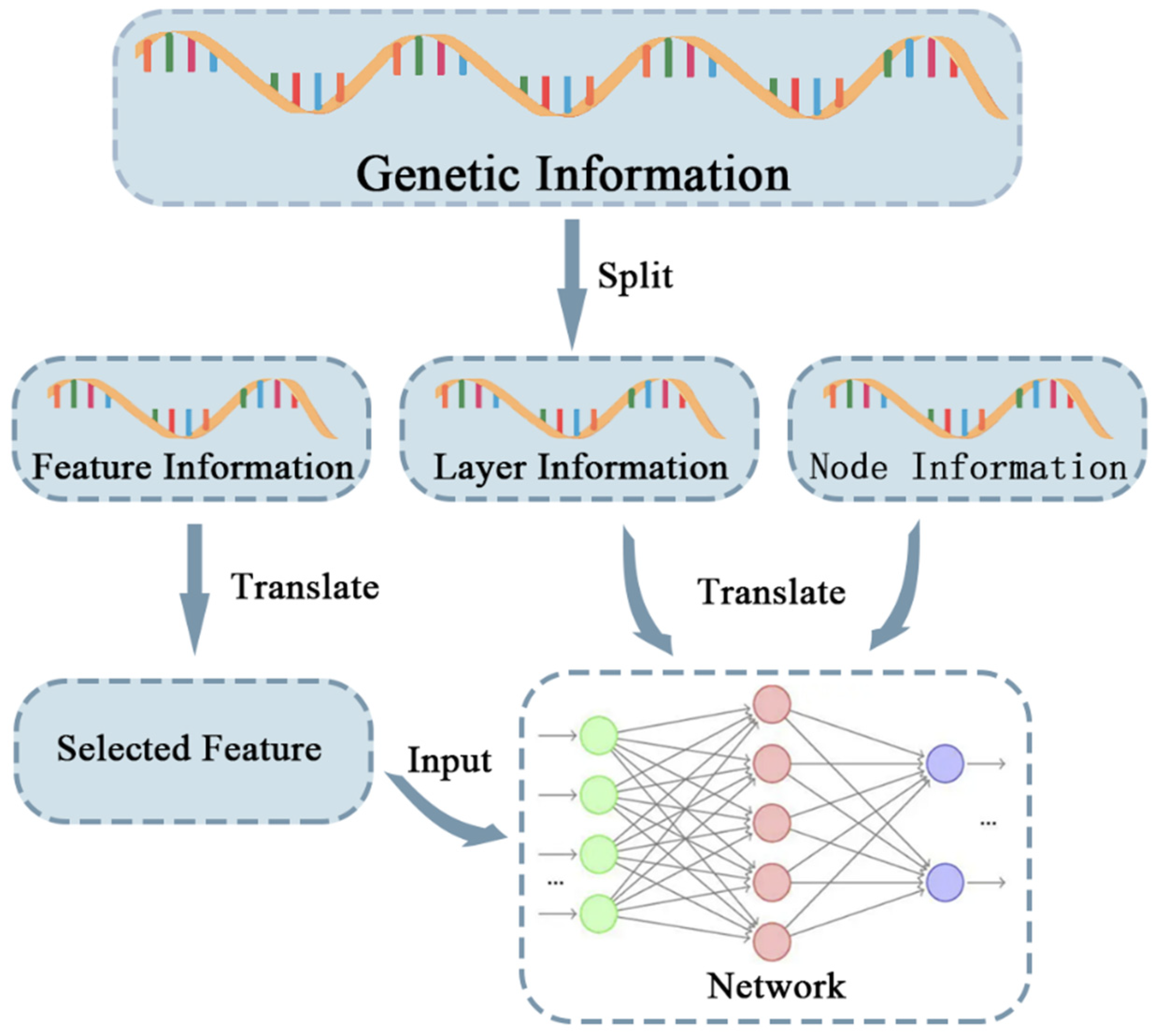



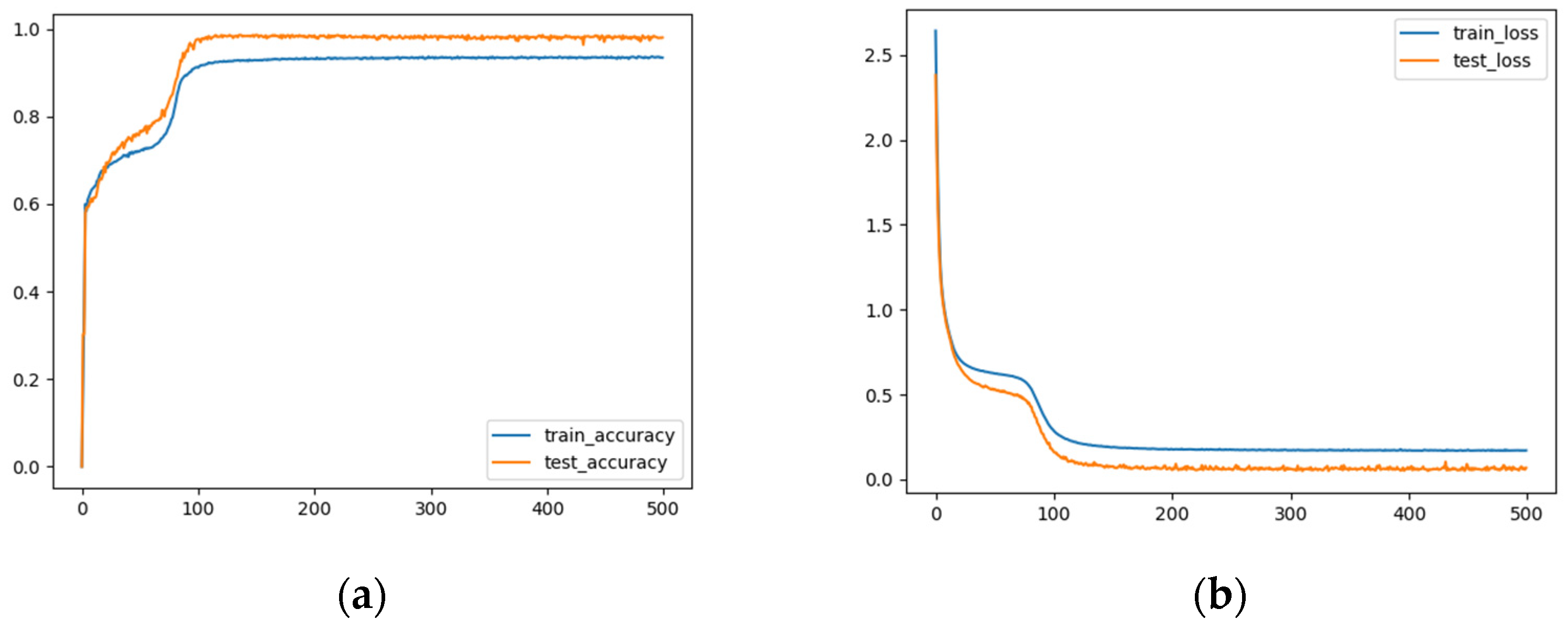
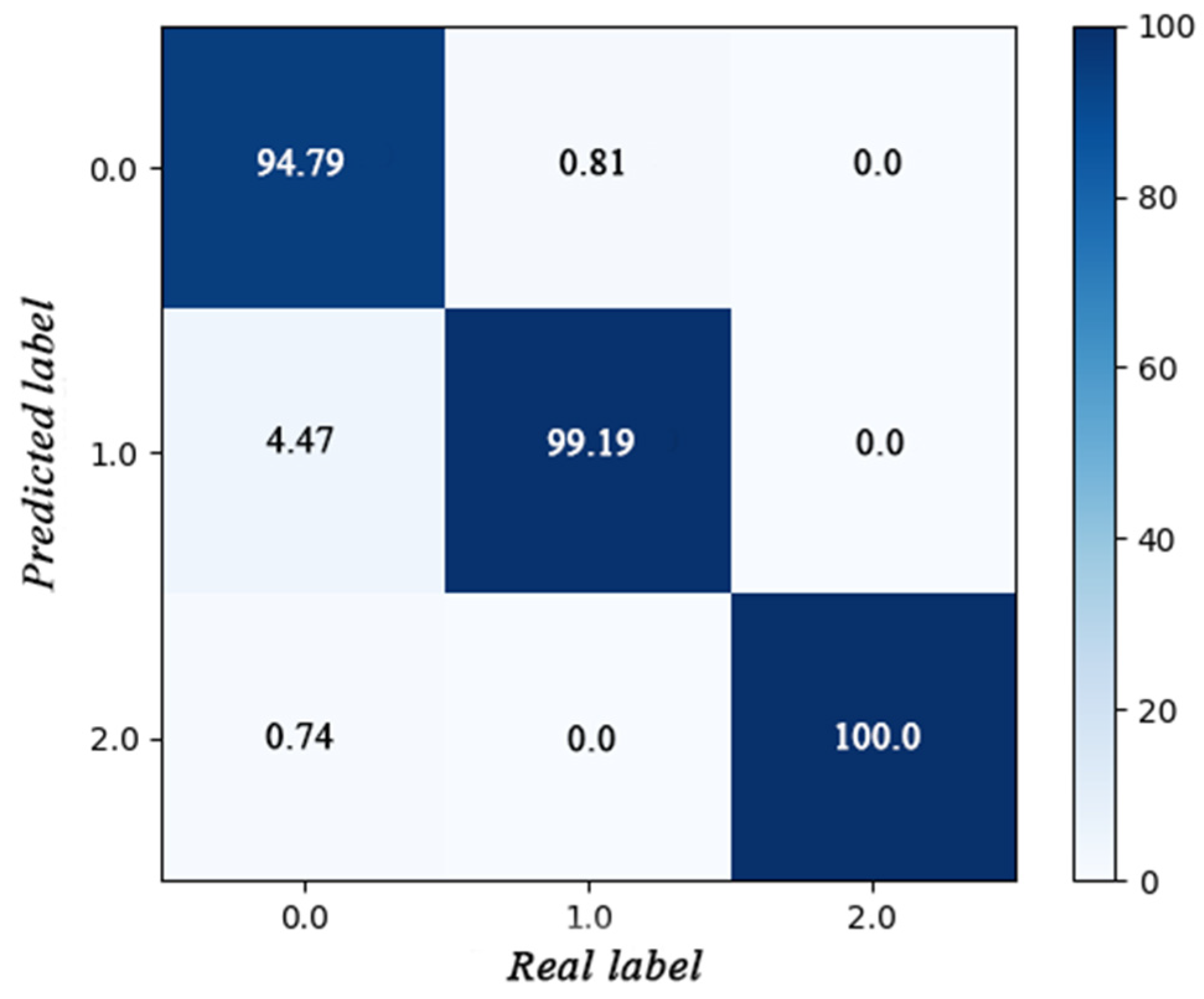
| Ref. | Feature Extraction Method | Classification Method |
|---|---|---|
| 2017, Kucukbay et al. [13] | MFCC | SVM |
| 2021, Bin et al. [14] | Fractal dimension | SVM |
| 2019, Zhong et al. [15] | Wavelet energy ratio, zero-crossing rate, mean value, peak index, SD, and waveform index | SVM |
| 2011 Jin et al. [16] | Probabilistic finite state automata | KNN |
| 2013 Huang et al. [17] | Wavelet packet node energy | KNN |
| 2010, Narayanaswami et al. [18] | Wavelet statistics, spectral statistics, cadence, and kurtosis | DT |
| 2011, Damarla et al. [7] | Energy of voice spectra, cadence, and frequency rhythm | NB |
| 2017, Choudhary et al. [10] | Automatic extraction | ANN |
| 2010, Park et al. [19] | Gait frequency and temporal pattern | GMM |
| 2021, Bin et al. [20,22] | Compression sensing | CNN |
| 2019, Wang et al. [21] | MFCC | CNN |
| 2019, Jin et al. [23] | Automatic extraction | CNN |
| 2019, Xu et al. [24] | Automatic extraction | RNN |
| 2021, Li et al. [25] | Automatic extraction | RNN |
| VI/dB | SPL/dB | Temperature | Date | |
|---|---|---|---|---|
| First recording | 36.88 | 25.71 | 26 °C | 30 May 2022 |
| Second recording | 38.82 | 26.32 | 25 °C | 31 May 2022 |
| Third recording | 39.03 | 24.49 | 23 °C | 1 June 2022 |
| Fourth recording | 41.99 | 28.44 | 23 °C | 11 June 2022 |
| Fifth recording | 40.83 | 26.69 | 27 °C | 15 June 2022 |
| Background Noise/Second | Person/Second | Vehicle/Second | |
|---|---|---|---|
| Train datasets | 2372 | 2483 | 1954 |
| Test datasets | 403 | 371 | 452 |
| Model | Accuracy | False Alarm Rate | Underreporting Rate | Time |
|---|---|---|---|---|
| GA-SVM | 98.56% | 0.96% | 0.48% | 20.27 s |
| Improved BPNN | 97.47% | 0.49% | 2.04% | 18.37 s |
| Vib-CNN | 98.16% | 0.43% | 1.41% | 200.83 s |
| ENN (Proposed in this paper) | 98.21% | 1.31% | 0.49% | 4.54 s |
Publisher’s Note: MDPI stays neutral with regard to jurisdictional claims in published maps and institutional affiliations. |
© 2022 by the authors. Licensee MDPI, Basel, Switzerland. This article is an open access article distributed under the terms and conditions of the Creative Commons Attribution (CC BY) license (https://creativecommons.org/licenses/by/4.0/).
Share and Cite
Xing, K.; Wang, N.; Wang, W. A Ground Moving Target Detection Method for Seismic and Sound Sensor Based on Evolutionary Neural Networks. Appl. Sci. 2022, 12, 9343. https://doi.org/10.3390/app12189343
Xing K, Wang N, Wang W. A Ground Moving Target Detection Method for Seismic and Sound Sensor Based on Evolutionary Neural Networks. Applied Sciences. 2022; 12(18):9343. https://doi.org/10.3390/app12189343
Chicago/Turabian StyleXing, Kunsheng, Nan Wang, and Wei Wang. 2022. "A Ground Moving Target Detection Method for Seismic and Sound Sensor Based on Evolutionary Neural Networks" Applied Sciences 12, no. 18: 9343. https://doi.org/10.3390/app12189343
APA StyleXing, K., Wang, N., & Wang, W. (2022). A Ground Moving Target Detection Method for Seismic and Sound Sensor Based on Evolutionary Neural Networks. Applied Sciences, 12(18), 9343. https://doi.org/10.3390/app12189343









